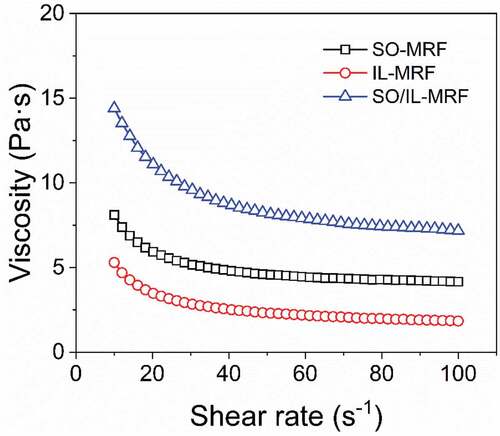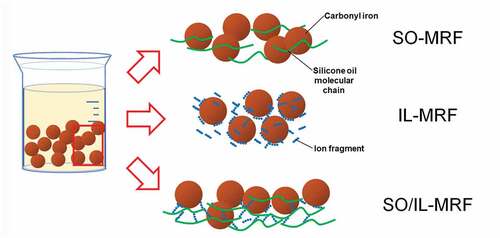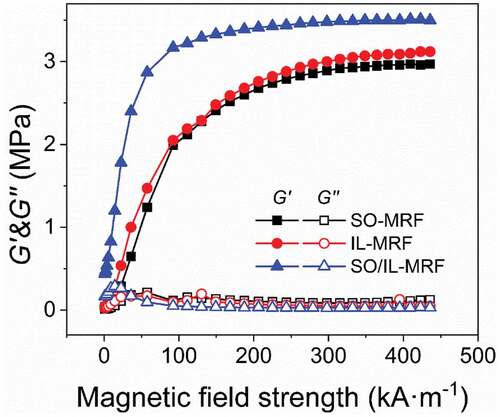ABSTRACT
A magnetorheological fluid (MRF) is a smart composite suspension composed of nonmagnetic liquid and soft magnetic particles. Carrier fluids can considerably influence the performance of MRFs; therefore, to investigate the effect of carrier fluids on MRFs, an SO/IL-MRF was prepared by mixing an ionic liquid (IL) with silicone oil (SO) in this study. Three types of MRF samples were prepared for experiments (pure SO, pure IL, and SO/IL). According to the experimental results, the SO/IL-MRF has better sedimentation stability than those based on pure SO and pure IL. Further, three methods were used to determine the shear yield stresses of the MRFs. The SO/IL-MRF achieved a higher shear yield stress than those of the other two because a network structure is formed between the ionic fragments and the molecular chains of the SO in the SO/IL-MRF. This increases the movement resistance of the particles in the carrier fluid, and it is unlike the mechanism of the IL-enhanced MRF. This work provides new ideas for improving the MRF performance.
Graphical abstractSO/IL-MRF prepared by mixing ionic liquid with silicone oil exhibited better sedimentation stability and higher shear yield stress. This is because a network structure is formed between the ionic fragments and the molecular chains of the silicone oil, which increases the movement resistance of the particles in the carrier fluid
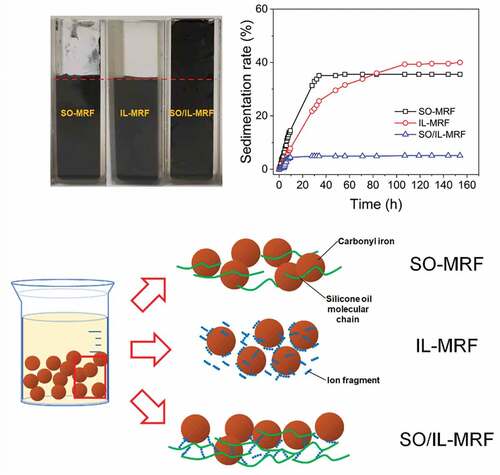
1. Introduction
A magnetorheological fluid (MRF) is a smart composite suspension that comprises a nonmagnetic liquid and soft magnetic particles [Citation1–4]. The rheology of the MRF can be modified from liquid to solid-like via the application of an external magnetic field [Citation4–6]. Owing to this property, MRFs have potential applications in various scenarios. For example, Oh et al. reviewed the application of MRF actuators in multi-degree-of-freedom systems [Citation7], and Lei et al. studied a seat suspension based on a compact variable stiffness and damping rotary magnetorheological damper [Citation8]. In addition, MRF is used in polishing liquids for precision surfaces [Citation9], magnetorheological clutches [Citation10], magneto resistive micro-displacement sensors [Citation11], etc.
The most common MRF combinations include silicone oil (SO) as a non-magnetic liquid and carbonyl iron powder (CIP) as soft magnetic particles with shear yield strengths up to 100 kPa [Citation4,Citation12]. However, this combination results in poor long-term stability because of the large difference in the densities of CIP and SO. Therefore, many studies have focused on improving the sedimentation stability of MRFs and on their magnetorheological properties [Citation1]. Existing studies have investigated the morphology and composition of magnetic particles; for example, magnetic particle coating [Citation13–17], surface modification [Citation18], synthesis of new particle morphology [Citation19–23], doping [Citation24], ATRP [Citation25,Citation26], etc. Further, other studies have shown that MRF sedimentation stability can be improved using a carrier fluid with higher viscosity or density [Citation27–29]. The results show that these methods can improve the settling stability of the magnetorheological fluid, and also improve the shear yield strength of the magnetorheological fluid. In fact, simultaneously improving the shear yield strength and settlement stability of MRFs has always been a problem to be solved by researchers. Visual observation is the most commonly used method to evaluate the settlement stability of MRF and was also the method used in this paper. This method is to inject the MRF into the cuvette and let it stand, and then calculate the sedimentation stability of the MRF by measuring the change of the liquid level. In addition, there are also methods to evaluate the sedimentation stability of MRF, such as the inductive method based on centrifugal sedimentation, the sedimentation potential method, and the light transmittance pulsation detection method [Citation2].
In our previous work, we found that the shear yield strength of CIP-based magnetorheological fluids can be improved using denser ionic liquids (ILs) [Citation30,Citation31]. Subsequent experiments revealed that using denser ILs did not improve the sedimentation stability of the IL-based MRF, and this was attributed to the particles being more likely to aggregate in ILs, which would affect the stability of the MRF.
Consider that mixing different carrier fluids is also a way to get a new carrier fluid. In this work, in order to preserve the high shear yield strength of IL-based MRF while being able to improve the sedimentation stability of MRF, we performed MRF prepared by mixing IL and commonly used SO with similar viscosity. This mixed MRF was analyzed to determine if it shows improvements in sedimentation stability.
2. Experimental
2.1. Preparation of MRFs
MRFs were prepared using typical mechanical agitation preparation procedures. The materials for preparing MRFs included SO (Beijing Hangping Silicone Co., Ltd.; 0.5 Pa s), 1-octyl-3-methylimidazolium tetrafluoroborate (IL; Linzhou Keneng Materials Technology Co., Ltd.; 0.44 Pa s), and CIP (CN-type from BASF with a particle size of 6.5–8.0 μm); the CIP content was 20% by volume. MRFs with pure SO, pure IL, and a 1:1 volume fraction of a mixture of SO and IL were prepared; they were referred to as SO-MRF, IL-MRF, and SO/IL-MRF, respectively. All reagents were of analytical grade and did not require further purification.
2.2. Evaluation of MRFs
The static observation method was used to test the sedimentation stability of the three MRF samples. To this end, the prepared MRF samples were placed in a 5 mL cuvette and left to stand at 25°C for observation. The clear liquid level was recorded, and the sedimentation rates of the three MRF samples were calculated.
The magnetorheological properties of the MRFs were measured using a Physica MCR301 rheometer (Anton Paar, Austria); the test gap was 1 mm. The shear yield strengths and viscosities of the MRFs were tested in the steady-state shear mode; their dynamic moduli were tested in the oscillatory shear mode. The test parameters reported in Ref [Citation31] were used without changes. The curve of shear stress increased linearly with a shear rate between 10 and 100 s−1 under different magnetic fields. The yield stress curves of MRFs with magnetic field changes at a shear rate of 1 s−1 were tested. The variation curves of the MRF moduli with shear strain amplitudes of 0.01–100% and applied magnetic field strengths of 0–436 kA·m−1 were tested using the oscillating shear mode. All tests were performed at 25°C.
3. Results and discussions
shows the sedimentation properties of the three MRFs. The SO/IL-MRF shows excellent sedimentation stability: the sedimentation rate is 5.1%, which is lower than those of SO-MRF (35.6%) and IL-MRF (40.0%). The viscosity of the selected IL is slightly lower than that of SO, and therefore, the settleability of the IL-MRF is expected to be slightly poor. However, the MRF achieves better settling stability after mixing the two carrier fluids, and therefore, zero-field viscosities of the three MRFs are tested to identify a cause for the better settling stability.
Figure 1. (a) Sedimentation photos of the three MRFs after 6 days; (b) Curves of the sedimentation rates of the three MRFs as a function of time.
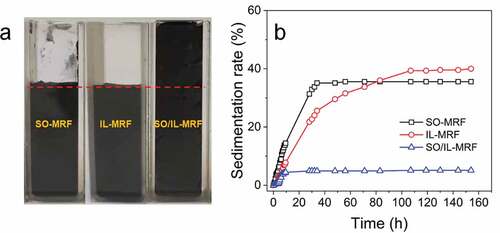
shows that the viscosities of the three MRFs; the viscosity of the IL-MRF is slightly lower than that of the SO-MRF. However, the SO/IL-MRF has a higher zero-field viscosity than that of SO, and it can be attributed to the strong van der Waals force (inductive and dispersion forces) formed between the IL with strong polarity and the SO. The van der Waals force forms a network structure in the carrier fluid mixed with IL and SO, and this increases the motion resistance of particles in the carrier fluid, which increases its dynamic viscosity. A schematic of the relationship between the carrier fluid and particles in the three MRFs is presented in .
Thus, the SO/IL-MRF has higher zero-field viscosity, which increases its shear yield stress. The shear yield stress of SO/IL-MRF would be between those of IL-MRF and SO-MRF without the above-mentioned mechanism. To confirm this, the shear stress curves of the three MRFs as a function of the shear rate at different magnetic field strengths were tested.
The shear yield stress curves of the three MRFs versus the magnetic field strength are obtained by fitting the Bingham model; the results are presented in . Although the Bingham model is not the best model for describing the MRF shear yield stress [Citation32], because its fitting is relatively simple and can meet the requirements for comparing different MRF performances, the Bingham model was used here for fitting. shows that the shear yield stress of SO/IL-MRF is higher than that of SO-MRF. However, it is slightly lower than that of IL-MRF at higher magnetic field strengths. Ionic fragments in the IL form an ionic layer on the particle surface, which improves the interaction between particles and enhances the shear yield stress of the IL-MRF; this was explained in our previous work [Citation31]. It remains difficult to explain why the shear yield stress of SO/IL-MRFs is lower than that of IL-MRFs; since the difference is small, it can be attributed to the insufficient accuracy of the model chosen for fitting. As shown in , the fitted line is slightly higher than that of the test data. Thus, the accuracy of determining the yield stress of a sample using this method depends on the rheometer resolution. The yield stress determined with a rheometer that can detect very small shear rates is lower than that determined with an older rheometer that does not have a very high resolution. The two commonly used methods for determining shear yield stresses of viscoelastic liquids were tested to determine the shear yield stresses of the three MRFs.
Figure 4. Curve of shear stress as a function of shear rate under different magnetic field strengths for (a) SO-MRF, (b) IL-MRF and (c) SO/IL-MRF; (d) Curves of shear yield stress as a function of magnetic field strength for the three MRFs fitted by the Bingham model.
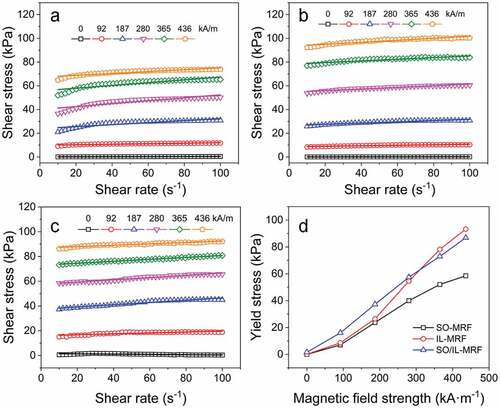
The absolute value of shear yield stresses of the MRFs are approximated by testing the curve of stress versus magnetic field strength at a shear rate of 1 s−1, as shown in . The shear yield stress of the SO/IL-MRF is higher than that of the IL-MRF, as expected. However, it is uncertain whether this method is more accurate. Storage modulus G’ represents the elastic portion of the material under measurement, and loss modulus G” represents the viscous portion of the material under measurement. Within a certain deformation range, both moduli remained constant, regardless of the set amplitude and frequency. The strain range with reversible elastic deformation is known as the linear viscoelastic region (LVE). The end point of the LVE is reached when the two moduli are no longer constant; this point is called the yield point, from which the structure of the sample becomes irreversibly destroyed. Based on this, the curves of G’ and G” for the three MRFs as a function of shear stress under different magnetic field intensities are tested, as shown in . shows a plot of the yield stress as a function of the magnetic field strength for the three MRFs. This plot achieves very similar values as that in , and SO/IL-MRF exhibits a higher yield stress; this proves that the previously suspected enhancement mechanism is correct.
Figure 5. Curves of absolute value of shear yield stress as a function of magnetic field strength for three MRFs at a shear rate of 1 s−1.

Figure 6. Dependence of the dynamic shear modulus (storage modulus G’ and loss modulus G”) under different magnetic field strengths of (a) SO-MRF, (b) IL-MRF and (c) SO/IL-MRF on the shear stress at a constant angular frequency of 10 rad·s−1; (d) The curve of the yield point of the three MRFs as a function of the magnetic field strength.
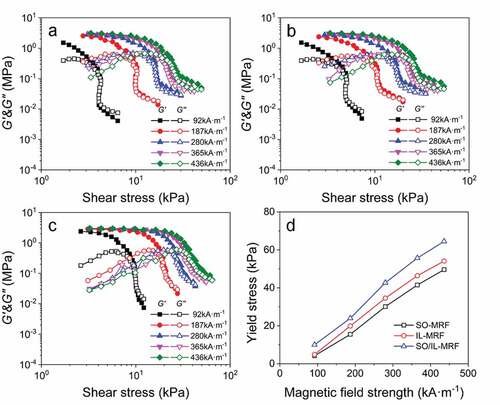
shows that SO/IL-MRF has a higher G’, which implies its internal structure is more stable. The reason for this stability cannot be the same as that of the IL-MRF. Thus, the special ‘structure’ formed in the SO/IL-MRF can be considered the key reason for its performance improvement.
4. Conclusions
SO/IL-MRFs were prepared by mixing ILs with SO. The experimental results showed that SO/IL-MRF had better sedimentation stability than MRF based on pure SO and pure IL, and its sedimentation rate was only 5.1% during the test; this was lower than those of SO-MRF (35.6%) and IL-MRF (40.0%). Further, it was shown that the SO/IL-MRF has a higher shear yield stress by comparing the results obtained using three different methods to determine the shear yield stress of the MRF. The improved performance of SO/IL-MRF is attributed to the formation of stronger van der Waals forces (especially the inductive force and dispersion force) between the IL with strong polarity and SO, which forms a network structure that increases the movement of particles in the carrier fluid resistance. This is unlike why pure ILs enhance MRF performance. Thus, this study provides a new idea for improving MRF performance.
In the future, the proportions and types of ILs will be further adjusted to obtain MRFs with better performance.
Acknowledgments
This research was funded by the National Natural Science Foundation of China under grant numbers 52178459 and 52002264.
Disclosure statement
No potential conflict of interest was reported by the author(s).
Additional information
Funding
References
- Kumar JS, Paul PS, Raghunathan G, et al. A review of challenges and solutions in the preparation and use of magnetorheological fluids. Int J Mech Mater Eng. 2019;14:13.
- Ashtiani M, Hashemabadi SH, Ghaffari A. A review on the magnetorheological fluid preparation and stabilization. J Magn Magn Mater. 2015;374:716–730.
- Xu Y, Gong X, Xuan S, et al. A high-performance magnetorheological material: preparation, characterization and magnetic-mechanic coupling properties. Soft Matter. 2011;7:5246.
- de Vicente J, Klingenberg DJ, Hidalgo-Alvarez R. Magnetorheological fluids: a review. Soft Matter. 2011;7:3701–3710.
- Kciuk M, Turczyn R. Properties and application of magnetorheological fluids. J Achieve Mater Manuf Eng. 2006;18:127–130.
- Carlson JD, Jolly MR. MR fluid, foam and elastomer devices. Mechatronics. 2000;10:555–569.
- Oh J, Sohn JW, Choi S. Applications of magnetorheological fluid actuator to multi-DOF systems: state-of-the-art from 2015 to 2021. Actuators. 2022;2:11: .
- Deng L, Sun S, Christie M, et al. Investigation of a seat suspension installed with compact variable stiffness and damping rotary magnetorheological dampers. Mech Syst Signal Pr. 2022;171:108802.
- Wang YQ, Yin SH, Huang H, et al. Magnetorheological polishing using a permanent magnetic yoke with straight air gap for ultra-smooth surface planarization. Precis Eng. 2015;40:309–317.
- Kikuchi T, Abe I, Nagata T, et al. Twin-driven actuator with multi-layered disc magnetorheological fluid clutches for haptics. J Intel Mat Syst Str. 2020;32:12;1045389X–20943958X.
- Xiaolin LAJZ. Magnetoresistive micro-displacement sensor based on magnetorheological fluid. Smart Mater Struct. 2021; 4:30: 045025: .
- Olabi AG, Grunwald A. Design and application of magneto-rheological fluid. Mater Design. 2007;28:2658–2664.
- Ronzova A, Sedlacik M, Cvek M. Magnetorheological fluids based on core–shell carbonyl iron particles modified by various organosilanes: synthesis, stability and performance. Soft Matter. 2021;17:1299–1306.
- Fang FF, Liu YD, Choi HJ, et al. Core–shell structured carbonyl iron microspheres prepared via dual-step functionality coatings and their magnetorheological response. Acs Appl Mater Inter. 2011;3:3487–3495.
- Liu YD, Fang FF, Choi HJ. Core–shell-structured silica-coated magnetic carbonyl iron microbead and its magnetorheology with anti-acidic characteristics. Colloid Polym Sci. 2011;289:1295–1298.
- Mrlík M, Ilčíková M, Pavlínek V, et al. Improved thermooxidation and sedimentation stability of covalently-coated carbonyl iron particles with cholesteryl groups and their influence on magnetorheology. J Colloid Interf Sci. 2013;396:146–151.
- Cvek M, Mrlik M, Ilcikova M, et al. A facile controllable coating of carbonyl iron particles with poly(glycidyl methacrylate): a tool for adjusting MR response and stability properties. J Mater Chem C, Mater optic electronic devices. 2015;3:4646–4656.
- Shen C, Oda Y, Matsubara M, et al. Magnetorheological fluids with surface-modified iron oxide magnetic particles with controlled size and shape. Acs Appl Mater Inter. 2021;13:20581–20588.
- Lee JY, Kwon SH, Choi HJ. Magnetorheological characteristics of carbonyl iron microparticles with different shapes. Korea-Aust Rheol J. 2019;31:41–47.
- Abe H, Naka T, Sato K, et al. Shape-controlled syntheses of magnetite microparticles and their magnetorheology. Int J Mol Sci. 2019; 15:20: .
- Tong Y, Dong X, Qi M. High performance magnetorheological fluids with flower-like cobalt particles. Smart Mater Struct. 2017;26:25023.
- Sedlacik M, Pavlinek V. Magnetorheology of dimorphic magnetorheological fluids based on iron nanorods. J Phys. 2017;790:12031.
- Xia Z, Wu X, Peng G, et al. A novel nickel nanowire based magnetorheological material. Smart Mater Struct. 2017;26:54006.
- Fang FF, Choi HJ, Jhon MS. Magnetorheology of soft magnetic carbonyl iron suspension with single-walled carbon nanotube additive and its yield stress scaling function. Colloids Surf A Physicochem Eng Asp. 2009;351:46–51.
- Hu B, Fuchs A, Huseyin S, et al. Atom transfer radical polymerized MR fluids. Polymer. 2006;47:7653–7663.
- Cvek M, Kollar J, Mrlik M, et al. Surface-initiated mechano-ATRP as a convenient tool for tuning of bidisperse magnetorheological suspensions toward extreme kinetic stability. Polym Chem UK. 2021;12:515–593.
- Lu Y, Zhou H, Mao H, et al. Liquid metal-based magnetorheological fluid with a large magnetocaloric effect. Acs Appl Mater Inter. 2020;12:48748–48755.
- Bombard AJF, Gonçalves FR, de Vicente J. Magnetorheology of carbonyl iron dispersions in 1-Alkyl-3-methylimidazolium ionic liquids. Ind Eng Chem Res. 2015;54:9956–9963.
- Guerrero-Sanchez C, Lara-Ceniceros T, Jimenez-Regalado E, et al. Magnetorheological fluids based on ionic liquids. Adv Mater. 2007;19:1740–1747.
- Zhao P, Li X, Tong Y, et al. Effect of the interface between magnetic particles and carrier liquids on magnetorheological properties and sedimentation of magnetorheological fluids: a molecular dynamics simulation and experimental insights. J Mol Liq. 2021;342:117377.
- Tong Y, Li X, Zhao P, et al. Improved magnetorheological properties by using ionic liquid as carrier liquid of magnetorheological fluids. Front Mater. 2021;8:.
- Cvek M, Mrlik M, Pavlinek V. A rheological evaluation of steady shear magnetorheological flow behavior using three-parameter viscoplastic models. J Rheol. 2016;60:687–694.

